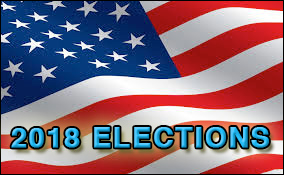Nov. 6, 2018 — Election Day has arrived, but it is likely that a majority of those planning to vote have already done so. Early voting totals are way up in most of the 37 states that employ a pre-election ballot casting procedure in comparison to the 2014 midterm election.
According to the University of Florida’s United States Elections Project, 25 of the 37 states report receiving more early votes than they did four years ago. None, however, is larger than Texas where early voting has already exceeded that grand total votes cast in 2014. The same also has occurred in Nevada, but it’s less surprising since the last midterm aggregate turnout there was unusually low.
In Texas, just under 4.9 million votes already have been received. In 2014, the aggregate early and Election Day vote was 4.72 million. In 2014, 44 percent of the total vote was cast early. If this same pattern occurs, the current election total turnout will exceed the 2016 presidential level participation figure of 8.96 million votes, however it is unlikely that will happen. How the increased turnout will affect the election outcome is undetermined at this point, but the high number of first-time voters suggest that Democrats could improve their typical standing.
Republicans looked positioned to hold the US Senate and will likely gain seats. The two most important races to observe about how majority status will change are in Arizona and Nevada. These two Republican defense states are pivotal. If the GOP holds both, they could gain 2-4 seats. If they lose both, the Democrats have a path to the majority though they would have to score an upset in either Texas or Tennessee because they look to be losing their seat in North Dakota.
Signals differ in Arizona and Nevada. While late polling bounces back and forth between Reps. Martha McSally (R-Tucson) and Kyrsten Sinema (D-Phoenix), early voting and the governor’s race look to be helping Republicans. In Nevada, while Sen. Dean Heller (R) seems to be up a bit in polling over his opponent, Rep. Jackie Rosen (D-Henderson), early voting and the governor’s race could be signaling improvement for Democrats.
While polling has favored Sen. Ted Cruz (R) by a small margin for weeks, the early turnout avalanche could be sending a different signal. But, it is important to remember, that early voting is easy in Texas, with voting centers even in retail establishments, so many more people may have availed themselves of the opportunity especially since it appears the undecided segment is low.
While Republicans look to be headed toward unseating Sen. Heidi Heitkamp (D) in North Dakota, toss-up contests going into Election Day are present in Florida, Indiana, and Missouri in addition to Arizona and Nevada. The Hoosier State will give us our first clue because that state and Kentucky are the first to close, where most polling places will cease accepting voters at 6 pm Eastern Standard Time.
The House does appear positioned to flip toward Democratic control. With 95 Republican seats in play to some degree, Democrats need to net at least 25, assuming they keep at least nine of the 11 districts where they are on defense. With Republicans playing defense in so many races and as many as 35 campaigns still rated as toss-ups, the Democrats’ prospects of gaining majority control have grown.
The key places to watch in observing majority clues begin with the tri-state area of New Jersey, New York, and Pennsylvania. Because Democrats have a large number of targets in the three states, their net must gain must at least be five seats. If they get closer to a net gain of eight, they are on their way to majority status.
Other states where they need to gain multiple seats are California (which, because of their predominant mail system that allows ballot acceptance well beyond election day and their counting system, means it may be weeks before we know the final outcome), Illinois, Michigan, Virginia, and probably Kansas. They also must gain seats in Arizona, Florida, Iowa, Minnesota, North Carolina, and Washington to attain a bare 218 majority.
Thus, the long 2018 midterm cycle is drawing to a close and the speculation and projections end tonight. Just when the post-election analysis is complete, the 2020 presidential election will then begin in earnest!

